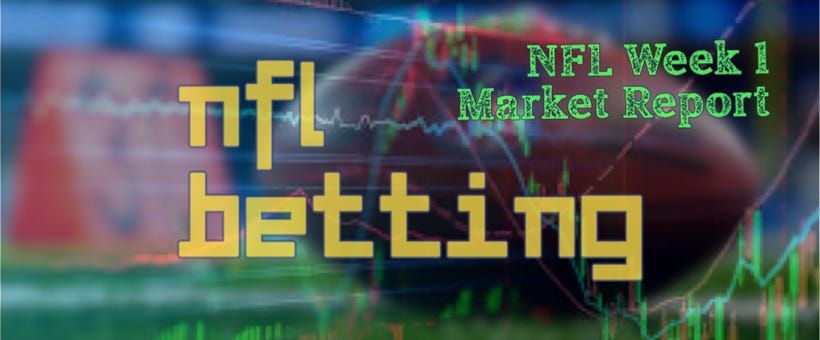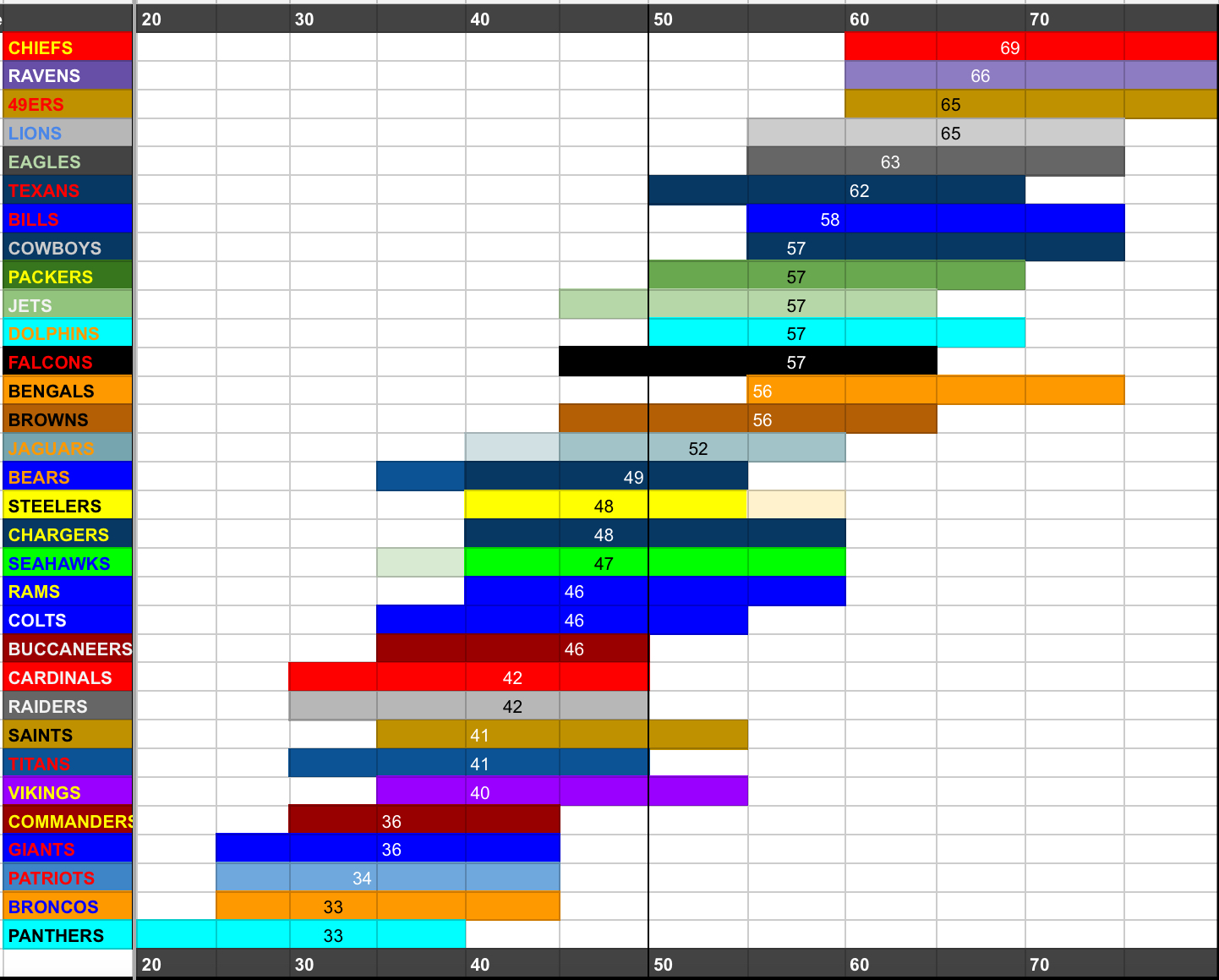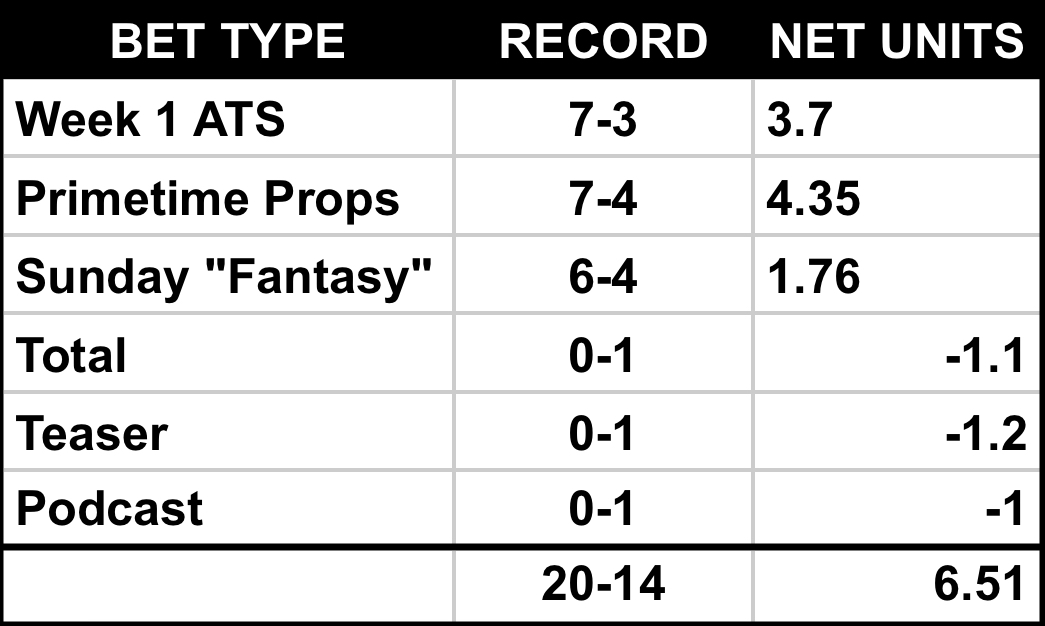The half-point mattered between the Jaguars-Dolphins, Cardinals-Bills, and Broncos-Seahawks. Even more significantly, a long-developing line move from Houston -1.5 to Houston -3 turned betting on the Texans from a good idea to a bad one. That’s four games out of the 16 in Week 1 that could have seen a win turn into a loss if you weren’t aware of why a team’s rating in the betting market matters.
Before the season, we explained the process of how the betting market takes the first odds offered from sportsbooks about a team’s quality - regular season win (RSW) totals - and translates that into a team rating.
The second data point we receive from oddsmakers and bettors alike, is the closing line (the last available point spread to bet before kickoff) for each game in Week 1. Taking those into account, we can adjust every team’s market rating to reflect where they are relative to the rest of the league.
For a breakdown of Week 1 and all the betting takeaways, check out the Tuesday episode of THE WINDOW: Sports betting podcastEstimated market ratings
These are not power rankings - a largely pointless exercise done for clicks - that simply lists each team in a made-up order. They are ratings, which allow for the possibility that teams can be perceived to be equal - or have a large gap - amongst the other 31 teams in the NFL.
Range
The chart above includes the range of what a team is capable of week-to-week. That’s where on-field handicapping comes into play. Since we can’t expect a team with a rating of 57 to play exactly at that level every week, we look for reasons why they might play higher or lower against a given opponent. Also, if a point spread suggests that one team is being rated closer to one edge or the other of their rating, that’s a sign the market is undervaluing or overvaluing them, and to bet accordingly.
Why is this important?
Good bettors bet numbers not teams. Since teams are made up of human beings, they’ll be inconsistent from week to week. Humans also heavily weigh what they’ve seen most recently, which creates inaccurate perceptions of how a team might play on average. That’s reflected in the betting market, point spreads shift in kind, and value is created.
Ie. The Colts go from losing at +1.5 to winning for those with +3 tickets, because public perception pushed the line out, giving Indianapolis more possible results to cover.
You can play along at home
You can create your own ratings, based off whatever premise you want. Simply list all 32 teams and give them a grade out of 100. Understand that no team should be rated higher than 80 or worse than 20.
Think about it this way - you can make a team 88/100, but you’re calling them a 15-2 team. They might end up 15-2, but that’s an unreasonable bar that you’re asking them to reach on a weekly basis. Conversely, a 12/100 would be a 2-15 team. While there might be a team that finishes with that record, that rating is going to result in some very high point spreads and you’ll constantly be projecting mediocre teams to cover big numbers.
What to do with your ratings
As laid out in the previous article referenced above, you can take your ratings and turn them into a projected point spread between any two teams. That’s a good starting tentpole for how you feel about the matchup. Since you’ve already registered your opinion of a team via your rating of them, a discrepancy to the point spread offered by a sportsbook creates a bet.
Market reflections
The 49ers dropped a bit with worry about Brandon Aiyuk and Trent Williams, then the late spread adjustment with Christian McCaffrey being ruled out. My guess is they go back up to the top of the league in short order.
Perhaps the market saw a lazy effort from the Bengals coming. As a projected 10.5-win team, their range should reach the upper echelon of the league, but they were shorted, as “only” 7.5-point favorites over the Patriots (and their league-worst RSW total). New England also got a bump compared to their season-long rating, likely from starting veteran Jacoby Brissett, who gives them their best chance of winning any given game.
There are eight teams with an estimated market rating (EMR) of 56-58, but you can see that the Bills, Bengals and Cowboys have a higher potential ceiling than the Jets, Falcons, and Browns. That is, until proven otherwise.
Though they didn’t end up covering, the Rams were clearly underrated on the closing line of Lions -5 on Sunday Night Football, since that point spread suggests they’re a slightly below-average team.
The biggest short-term injury suffered in Week 1 was to Jordan Love. We’ll see how far the Packers’ rating falls without Love, but a point spread that would have been Packers -5 with their starting quarterback is now Colts -3. What would it take for a team rated below-average (like Indianapolis) to be a 3-point road favorite? An opponent expected to play like a 27/100. Bettors are asked to determine whether that’s the level Green Bay will play at with Malik Willis at the helm.
As we turn the page on Week 1, the main question to answer will either be:
Is a team’s opening game result worthy of a rating change that HAS happened?
Is a team’s opening game result worthy of a rating change that HASN’T?







